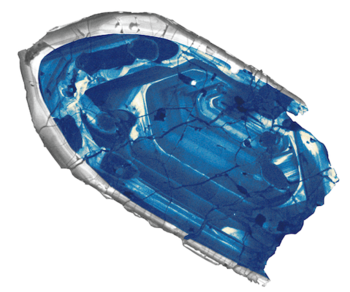Oldest bit of Earth’s crust among attractions at Geology Museum open house

Visiting first-grade students look up at a replica of stalactites as they walk through a cave display at the Geology Museum in December 2013. The children were on a field trip from Midvale Elementary School in Madison.
It promises to be a trip through geologic time: from a look at the oldest piece of Earth’s crust, to the earliest smells on our planet, to a recently crash-landed Martian meteorite.
On Saturday, April 5, the University of Wisconsin–Madison’s Geology Museum will host an open house as part of the weekend’s Science Expeditions. Visitors will be treated to geologic souvenirs, a talk by a scientist and perhaps a few surprises.
“It’s always nice to have an ace up the sleeve,” says museum Director Rich Slaughter.
And as part of the museum’s 165th anniversary year last year, it held a contest to create a new Babcock ice cream flavor. The winning creation, imagined by a 9-year-old museum visitor, will be unveiled Saturday. It may or may not be made of bone, amber and coal.

The oldest piece of Earth’s crust — a 4.4 billion-year-old zircon crystal — can be viewed under a microscope Saturday, the only day the Geology Museum plans to put it on display.
Image courtesy of John Valley
Geoscience Professor John Valley will be there all day to show the 4.4 billion-year-old zircon, recently proven to be the oldest known material from the Earth.
At the open house, visitors will be able to view the miniature crystal under a microscope — the only time the museum plans to have the rare object on display.
“What’s most impressive about it is how totally unimpressive it is,” Valley says, since a vast amount of information is carried by such a tiny object.
The zircon is 400 micrometers long and 200 micrometers wide, or about the width of two human hairs lying side-by-side.
Valley and his group determined the age of the zircon years ago using an ion microprobe — the first IMS-1280 in the world — but it wasn’t until his lab turned to brand new technology, an atom microprobe manufactured in Madison by instrumentation developer CAMECA, that confirmation was possible.
It promises to be a trip through geologic time: from a look at the oldest piece of Earth’s crust, to the earliest smells on our planet, to a recently crash-landed Martian meteorite.
The ion microprobe will also be on display Saturday.
In fitting with the day, guests will be able to visit four stations coinciding with eras on Earth’s geologic timescale. Slaughter even has some new fossils to share at the Cenozoic table, including a baby mastodon tooth and an elephant bird egg.
Geoscience Assistant Professor Stephen Meyers will give a talk at 1 p.m., Telling Time with a Rock Clock, and seismology Professor Cliff Thurber will introduce visitors to the new touch-screen earthquake display.
In addition to the displays, visitors can also peek into the museum’s recently renovated Fossil Preparation Lab. Don’t be surprised to spot the bones of a prehistoric creature or two.
The museum, located in Weeks Hall at 1215 W. Dayton St., will be open from 9 a.m. to 4 p.m. for the open house, a few hours longer than its usual Saturday hours.
